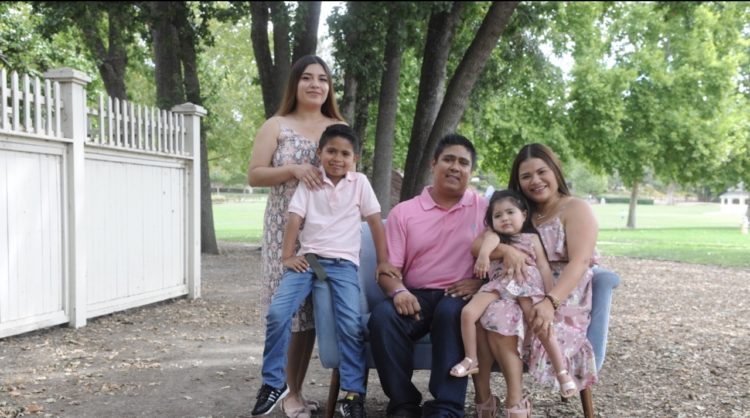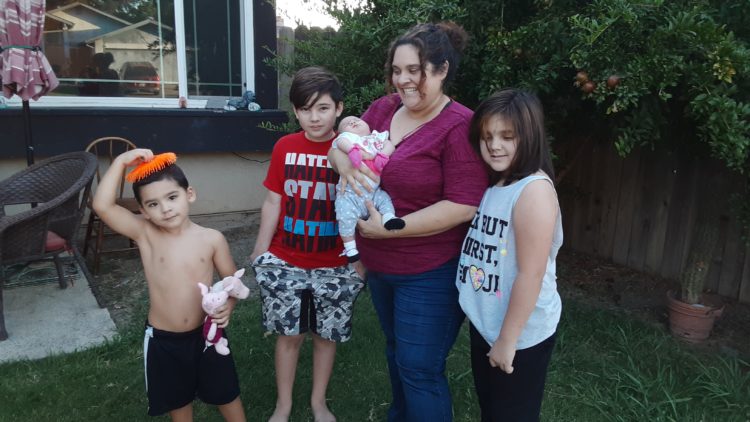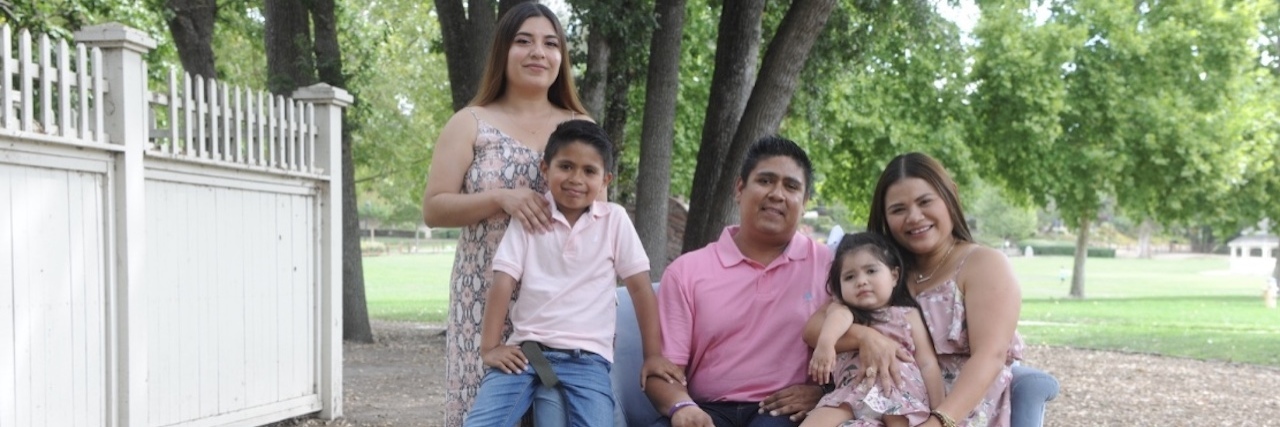Critical Windows: Children Often Miss Out on Services Because of Labyrinth State System
As Karla Garcia of San Francisco watched her third child grow, she had a feeling something was different.
At 4 months old, Brianna still couldn’t keep her head steady or lift it up when she was on her stomach, a milestone babies typically reach by two months old. She also didn’t hold her mother’s gaze or look intently at other familiar faces. That’s something babies normally do within their first month of life.
But when Garcia raised her concerns with Brianna’s pediatrician, the doctor said it was too soon to tell whether or not her daughter’s development was normal. It would take Garcia another year and a half of persistently demanding answers and seeking help before Brianna finally received an official diagnosis: She had a genetic, neurological disorder called Rett’s Syndrome, which can result in developmental delays and numerous health problems.
“The hardest part was feeling like the pediatrician was not listening to me,” said Garcia, who is originally from El Salvador and has two older children. “The wait before we got an actual diagnosis was really hard.”
Garcia is not alone. In California, parents who suspect their child has a developmental delay often wait months or even years to get a formal diagnosis and to obtain services, according to research by the First 5 Center for Children’s Policy. By the time these children receive treatment — which is often contingent upon getting a diagnosis — they may have missed out on a critical window of time during which interventions for disorders such as autism or Rett’s Syndrome can be most effective. These delays have likely become more acute during the pandemic, as families are less likely to be visiting doctors for check-ups and children aren’t interacting as much with early childhood professionals who can spot signs of developmental challenges, experts with the First 5 Center said.

A major reason for the delay, advocates and parents say, is the complexity and inefficiency of the state’s system for detecting and serving young children with developmental issues. To get services for their children, parents often must navigate a dizzying array of health care providers, special education entities, and insurance programs, each with their own eligibility criteria and interpretation of the rules, the report found. Many parents said they received little support or guidance to help them with this process.
“I felt like I had been shot out like a pinball and I just kept bumping into these different things that were kind of pushing me along,” said Heather Breen of Walnut Creek in Contra Costa County. Breen fought for over a year to get a diagnosis and therapy for her daughter, Clara, who has autism and a seizure disorder. Clara was almost 4 when she finally started getting services, even though her parents first noticed possible delays when she was 2.
“No one put their arm around me and shepherded me,” said Breen. “Each person along the way was just doing their little piece and there was no cohesive system where each person understood and knew what the previous person had said and done.”
A Labyrinth of Pathways
To illustrate the system’s complexity, the First 5 Center for Children’s Policy published an interactive flowchart illustrating the many pathways a family with a child younger than 4 typically navigates to get support for a developmental or social-emotional health concern. The chart focuses on children enrolled in Medi-Cal, the state and federally funded health insurance program for families with limited incomes, which covers more than half of children ages 5 and under in California. Many children with disabilities qualify for some type of Medi-Cal even if their family has private insurance or earns more than the eligibility limit for children without disabilities. If a family has private insurance, Medi-Cal may pick up expenses not covered by the insurance.
The chart shows at least seven possible systems that a family may have to contend with, including Medi-Cal, California Children’s Services, Early Start programs through local Regional Centers or education agencies, community-based programs, managed-care plans, and county mental health plans. That doesn’t include the initial challenge of identifying a problem and obtaining a diagnosis, which can add further complications and delays to getting treatment.
“The effect is that months pass without kids getting the services that they need,” said Sarah Crow, Managing Director of the First 5 Center for Children’s Policy. “Those are critical months when the brain is developing at a rate unlike any other time in a human’s development. A six or eight-month delay for an adult is annoying … but for a baby or a toddler that effect is so much more pronounced, so much more critical for their long-term outcomes.”
In an emailed statement through spokesman Anthony Cava, the Department of Health Care Services (DHCS), which oversees Medi-Cal and California Children’s Services, said families can get help accessing appropriate care for children with special health care needs. The source of assistance depends on which type of Medi-Cal they are enrolled in. If a child is enrolled in a Medi-Cal managed care plan, then that plan can help families coordinate care, including with their local Regional Center and county mental health plan, the statement said. DHCS also has a mental health ombudsman who can assist families experiencing challenges navigating the system.
Children enrolled in Medi-Cal’s Home and Community-Based Services waiver program (available to children with disabilities whose family incomes are higher than the regular financial eligibility threshold for Medi-Cal) are assigned a case manager who is responsible for assisting families in coordinating services, the statement said.

Fighting for Her Child
Leticia DeGracia, a single mother of three children in Sacramento, almost gave up trying to enroll her son with autism, Brandon, in Medi-Cal. She had other health insurance through her job as a phlebotomist, but her earnings of about $40,000 a year weren’t enough to cover the many co-payments and $1,700 in out-of-pocket expenses required to get Brandon diagnosed and receiving applied behavioral therapy, she said.
DeGracia said she spent hours on the phone with Medi-Cal representatives, filling out forms and sending in documents. Eventually, after several months, she succeeded in enrolling her son.
“I knew that time was of the essence,” she said. “I was like, ‘I’ve got to get him into therapy.’”
She worries about the parents who don’t have the time, knowledge or energy to persist the way she did, and what that means for their kids.
“The hoops they make the parents go through … There needs to be a change,” she said.
The state Department of Health Care Services, which oversees Medi-Cal, said it did not have enough details to comment on DeGracia’s specific case. However, for families that also have private insurance, federal law requires that the private plan be billed first before Medi-Cal is billed.
“This process may require additional coordination between the different health coverage plans,” agency spokesperson Anthony Cava said.
Finding Solutions
Complexity is just one of the challenges weighing on California’s system for identifying and treating children with developmental and behavioral issues, said Alexandra Parma, senior policy research associate at the First 5 Center for Children’s Policy. The state’s Medi-Cal system (known nationally as Medicaid) is more complicated than in many other states, she said. For example, some children are enrolled in managed care plans, others in fee-for-service plans, and different entities provide behavioral health care services depending on what the child needs.
Other flaws include a widespread confusion about the rules, a shortage of providers, and lack of care coordination. The situation has become even harder for families during the pandemic, when they’re less likely to be interacting with doctors, teachers and other professionals, said Crow. California already has one of the lowest developmental screening rates in the country, at 26 percent, and research shows children of color are especially likely to face delays in receiving a diagnosis for developmental delays.
Angela Rothermel, who focuses on early childhood policy for the advocacy organization Children Now, said the organization agrees with the First 5 Center’s findings.
“The early identification and intervention system in California is fragmented, convoluted, and it’s not reaching enough kids,” she said.
The system is “not supporting families” who need help, and is “long overdue for change in California,” Rothermel said.
Efficient and effective early intervention is best for kids, and also cost-effective for government because identifying and treating childhood challenges at an early age often means children do better and require fewer interventions later on, she explained.
California has taken some steps toward improving the system — increasing the reimbursement rate last year for specialists treating children in the Early Start program, and tightening up language requiring regular developmental screenings for young children enrolled in Medi-Cal. But more needs to be done to make the system less complex for families, Rothermel said.
The First 5 Center made several recommendations for improving California’s system, including clarifying and expanding eligibility for early intervention, improving statewide data collection, and increasing accountability for managed care plans. The state also needs to focus on providing preventive services to young children at risk for developmental or mental health problems, rather than insisting on a clinical diagnosis first which isn’t always feasible when children are small and can delay an opportunity to intervene before a treatable problem becomes worse, said Crow.
Support for Parents
For Breen, what would have helped is having a central person to mentor and guide her through the process of getting her daughter screened and into treatment, she said. Program staff also needs to be more forthcoming about what services are available and how to apply for them, she said. For example, she didn’t find out that she could qualify for financial help from the state to stay home and care for her daughter until several years after she was diagnosed, Breen said. If she had found out earlier it would have alleviated a lot of stress on her family, she said.
“Let’s make it easier on the parents,” she said. “If you want the kids to do well, they need parents that are prepared and informed and have the resources they need.”
Meanwhile, Karla Garcia did eventually get services for Brianna, including speech and physical therapy and treatment for her heart. She advises other parents not to give up on finding someone who will take their concerns seriously if they suspect their child has a delay.
“Keep insisting and remember you can change your pediatrician if they aren’t listening to you,” she said. “Do it as soon as possible.”
This story was produced in partnership with the California Health Report.
Photo by Moment by Moment Photography

